BIM & Collaborative Contracting: Cultural Impact Analysis Report
VerifiedAdded on 2023/06/03
|37
|8979
|266
Report
AI Summary
This report investigates the utilization of Building Information Modeling (BIM) in collaborative contracting within diverse construction cultures. It begins by introducing BIM, its various levels, and the concept of collaborative contracting, highlighting the research gap concerning the challenges of implementing BIM in collaborative projects across different cultural contexts. The literature review covers collaborative contracting in the construction industry, the role of BIM in fostering collaboration, and an exploration of construction cultures in different countries, comparing their practices. The research aims to understand BIM's usage in collaborative contracting from a cultural standpoint, with objectives including studying different BIM levels, identifying barriers to BIM adoption, and analyzing the impact of construction cultures on BIM use. The methodology involves secondary source analysis and case studies, examining projects like the Venetian Casino in Macau, Nya Karolinska Solna in Sweden, and North Shore Hospital’s Elective Surgery Centre in New Zealand. The discussion delves into the performance of BIM in collaborative contracting, the impact of different construction cultures, strengths and weaknesses of BIM and collaborative contracting in various cultures, and lessons learned for future practices, concluding with contributions, suggestions for further research, and an overview of actual BIM results and impacts.
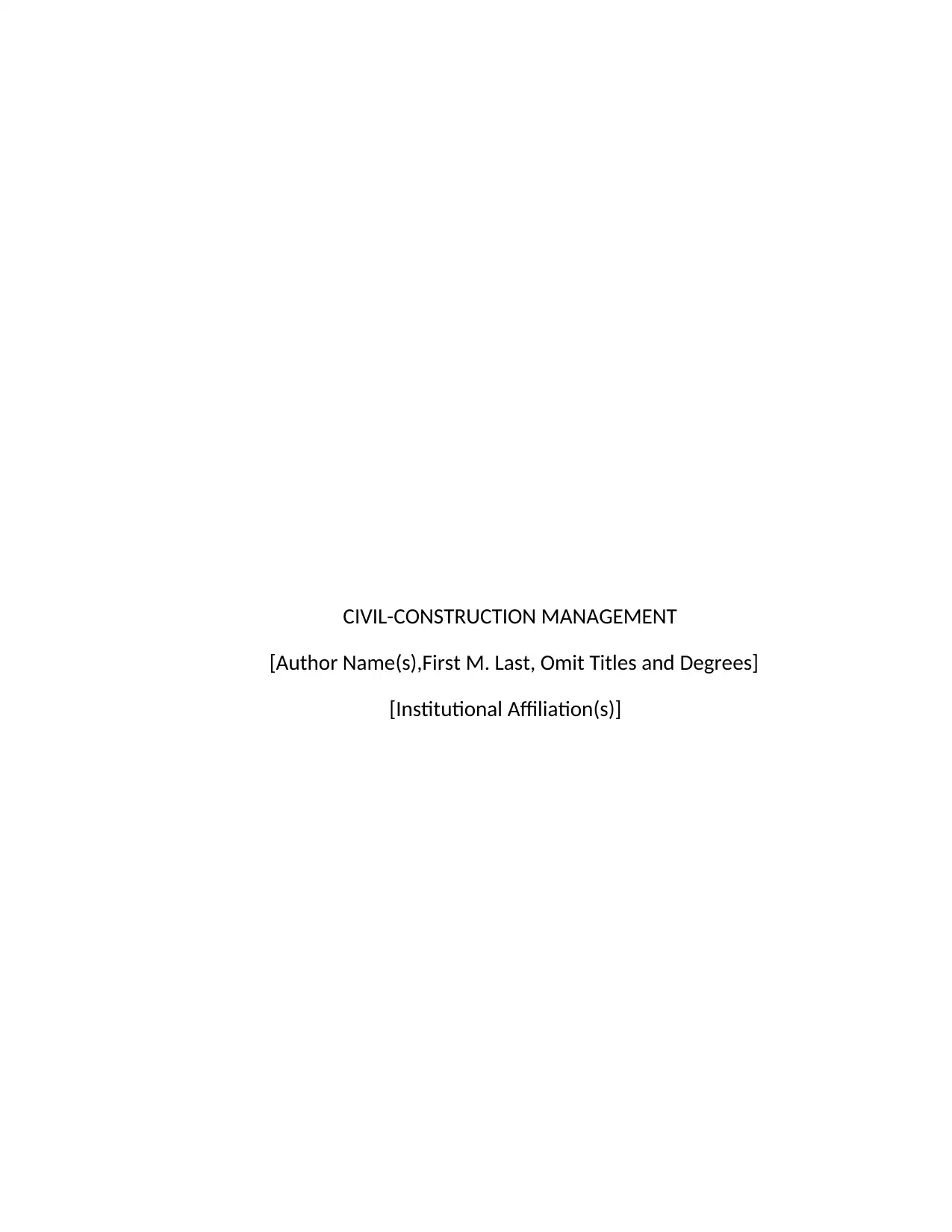
CIVIL-CONSTRUCTION MANAGEMENT
[Author Name(s),First M. Last, Omit Titles and Degrees]
[Institutional Affiliation(s)]
[Author Name(s),First M. Last, Omit Titles and Degrees]
[Institutional Affiliation(s)]
Paraphrase This Document
Need a fresh take? Get an instant paraphrase of this document with our AI Paraphraser
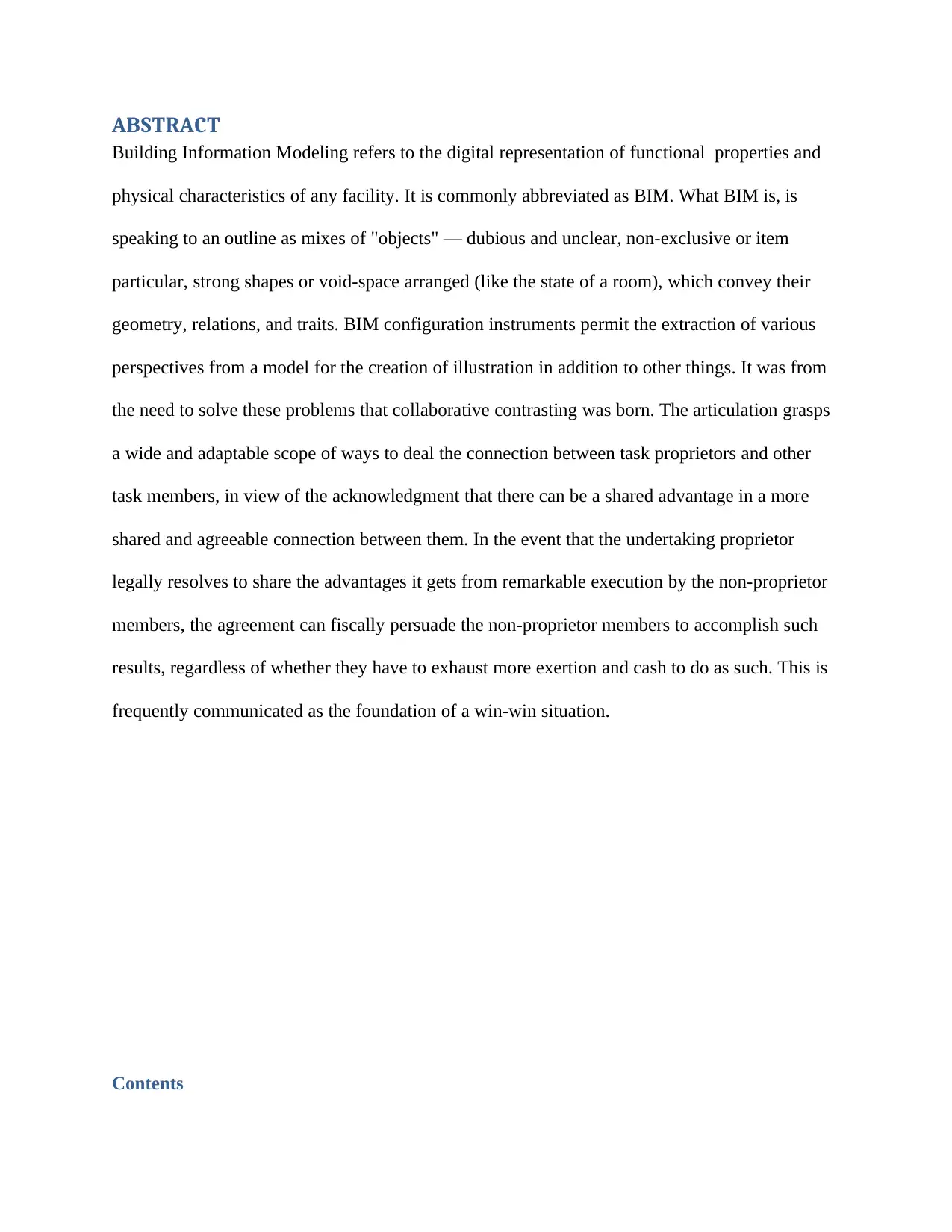
ABSTRACT
Building Information Modeling refers to the digital representation of functional properties and
physical characteristics of any facility. It is commonly abbreviated as BIM. What BIM is, is
speaking to an outline as mixes of "objects" — dubious and unclear, non-exclusive or item
particular, strong shapes or void-space arranged (like the state of a room), which convey their
geometry, relations, and traits. BIM configuration instruments permit the extraction of various
perspectives from a model for the creation of illustration in addition to other things. It was from
the need to solve these problems that collaborative contrasting was born. The articulation grasps
a wide and adaptable scope of ways to deal the connection between task proprietors and other
task members, in view of the acknowledgment that there can be a shared advantage in a more
shared and agreeable connection between them. In the event that the undertaking proprietor
legally resolves to share the advantages it gets from remarkable execution by the non-proprietor
members, the agreement can fiscally persuade the non-proprietor members to accomplish such
results, regardless of whether they have to exhaust more exertion and cash to do as such. This is
frequently communicated as the foundation of a win-win situation.
Contents
Building Information Modeling refers to the digital representation of functional properties and
physical characteristics of any facility. It is commonly abbreviated as BIM. What BIM is, is
speaking to an outline as mixes of "objects" — dubious and unclear, non-exclusive or item
particular, strong shapes or void-space arranged (like the state of a room), which convey their
geometry, relations, and traits. BIM configuration instruments permit the extraction of various
perspectives from a model for the creation of illustration in addition to other things. It was from
the need to solve these problems that collaborative contrasting was born. The articulation grasps
a wide and adaptable scope of ways to deal the connection between task proprietors and other
task members, in view of the acknowledgment that there can be a shared advantage in a more
shared and agreeable connection between them. In the event that the undertaking proprietor
legally resolves to share the advantages it gets from remarkable execution by the non-proprietor
members, the agreement can fiscally persuade the non-proprietor members to accomplish such
results, regardless of whether they have to exhaust more exertion and cash to do as such. This is
frequently communicated as the foundation of a win-win situation.
Contents

ABSTRACT....................................................................................................................................................2
1.INTRODUCTION....................................................................................................................................5
1.1 Research Gap.....................................................................................................................................7
2 LITERATURE REVIEW.........................................................................................................................7
2.1 Collaborative Contracting in the construction industry......................................................................7
2.2 Building Information Modeling (BIM) for collaboration.................................................................10
2.3 Cultures and implementations of the construction industry in different countries...........................11
Why culture?.....................................................................................................................................11
Culture Levels.......................................................................................................................................12
Chinese construction culture..................................................................................................................13
Australian Construction Culture............................................................................................................13
2.4 Comparison of different cultures of practice from different countries.............................................14
3. AIM OF RESEARCH...........................................................................................................................15
4. OBJECTIVES.......................................................................................................................................15
5.METHODOLOGY.................................................................................................................................15
Secondary sources.................................................................................................................................16
Experiments...........................................................................................................................................17
Merits....................................................................................................................................................17
Demerits................................................................................................................................................18
Research methodology procedures........................................................................................................18
6.RESULTS...............................................................................................................................................19
6.1 Case Study 1: the Venetian Casino, Parcel 5 & 6, Cotai, Macau.....................................................19
Venetian Casino.....................................................................................................................................19
BIM Collaborative contracting at Venatian Casino..............................................................................20
Progress at the project............................................................................................................................21
How Barriers to BIM collaborative constructing have been addressed..................................................21
Training and Education.........................................................................................................................21
Change in the work process...................................................................................................................22
6.2 Case Study 2– Nya Karolinska Solna..............................................................................................22
BIM Collaborative contracting at the NKS Project................................................................................23
Construction Phase................................................................................................................................24
How Barriers were addressed................................................................................................................24
1.INTRODUCTION....................................................................................................................................5
1.1 Research Gap.....................................................................................................................................7
2 LITERATURE REVIEW.........................................................................................................................7
2.1 Collaborative Contracting in the construction industry......................................................................7
2.2 Building Information Modeling (BIM) for collaboration.................................................................10
2.3 Cultures and implementations of the construction industry in different countries...........................11
Why culture?.....................................................................................................................................11
Culture Levels.......................................................................................................................................12
Chinese construction culture..................................................................................................................13
Australian Construction Culture............................................................................................................13
2.4 Comparison of different cultures of practice from different countries.............................................14
3. AIM OF RESEARCH...........................................................................................................................15
4. OBJECTIVES.......................................................................................................................................15
5.METHODOLOGY.................................................................................................................................15
Secondary sources.................................................................................................................................16
Experiments...........................................................................................................................................17
Merits....................................................................................................................................................17
Demerits................................................................................................................................................18
Research methodology procedures........................................................................................................18
6.RESULTS...............................................................................................................................................19
6.1 Case Study 1: the Venetian Casino, Parcel 5 & 6, Cotai, Macau.....................................................19
Venetian Casino.....................................................................................................................................19
BIM Collaborative contracting at Venatian Casino..............................................................................20
Progress at the project............................................................................................................................21
How Barriers to BIM collaborative constructing have been addressed..................................................21
Training and Education.........................................................................................................................21
Change in the work process...................................................................................................................22
6.2 Case Study 2– Nya Karolinska Solna..............................................................................................22
BIM Collaborative contracting at the NKS Project................................................................................23
Construction Phase................................................................................................................................24
How Barriers were addressed................................................................................................................24
⊘ This is a preview!⊘
Do you want full access?
Subscribe today to unlock all pages.

Trusted by 1+ million students worldwide

6.3 Case study 3-North Shore Hospital’s Elective Surgery Centre (NZ)...................................................25
North Shore Hospital’s Elective Surgery Centre...................................................................................25
BIM Collaborative contracting at -North Shore Hospital’s Elective Surgery Centre............................26
The progress of the project....................................................................................................................27
How barriers to BIM have been addressed............................................................................................27
Training and Education.........................................................................................................................28
Change of work process........................................................................................................................28
7. DISCUSSIONS.....................................................................................................................................29
7.1 Performance of BIM for collaborative contracting..........................................................................29
7.2 Impact of different construction cultures.........................................................................................29
7.3 Strength and weakness of BIM and collaborative contracting from different cultures.....................31
7.4 Lesson learn from the weakness of current cultural practices for future..........................................32
8.0 CONCLUSION...................................................................................................................................32
8.1 Contribution.....................................................................................................................................33
8.2 Further Research..............................................................................................................................33
Actual results of BIM and collaborative contracting.........................................................................33
The impact of BIM and collaborative contracting:............................................................................34
Measurement of BIM and collaborative contracting results..............................................................34
9.0 REFERENCES........................................................................................................................................35
North Shore Hospital’s Elective Surgery Centre...................................................................................25
BIM Collaborative contracting at -North Shore Hospital’s Elective Surgery Centre............................26
The progress of the project....................................................................................................................27
How barriers to BIM have been addressed............................................................................................27
Training and Education.........................................................................................................................28
Change of work process........................................................................................................................28
7. DISCUSSIONS.....................................................................................................................................29
7.1 Performance of BIM for collaborative contracting..........................................................................29
7.2 Impact of different construction cultures.........................................................................................29
7.3 Strength and weakness of BIM and collaborative contracting from different cultures.....................31
7.4 Lesson learn from the weakness of current cultural practices for future..........................................32
8.0 CONCLUSION...................................................................................................................................32
8.1 Contribution.....................................................................................................................................33
8.2 Further Research..............................................................................................................................33
Actual results of BIM and collaborative contracting.........................................................................33
The impact of BIM and collaborative contracting:............................................................................34
Measurement of BIM and collaborative contracting results..............................................................34
9.0 REFERENCES........................................................................................................................................35
Paraphrase This Document
Need a fresh take? Get an instant paraphrase of this document with our AI Paraphraser
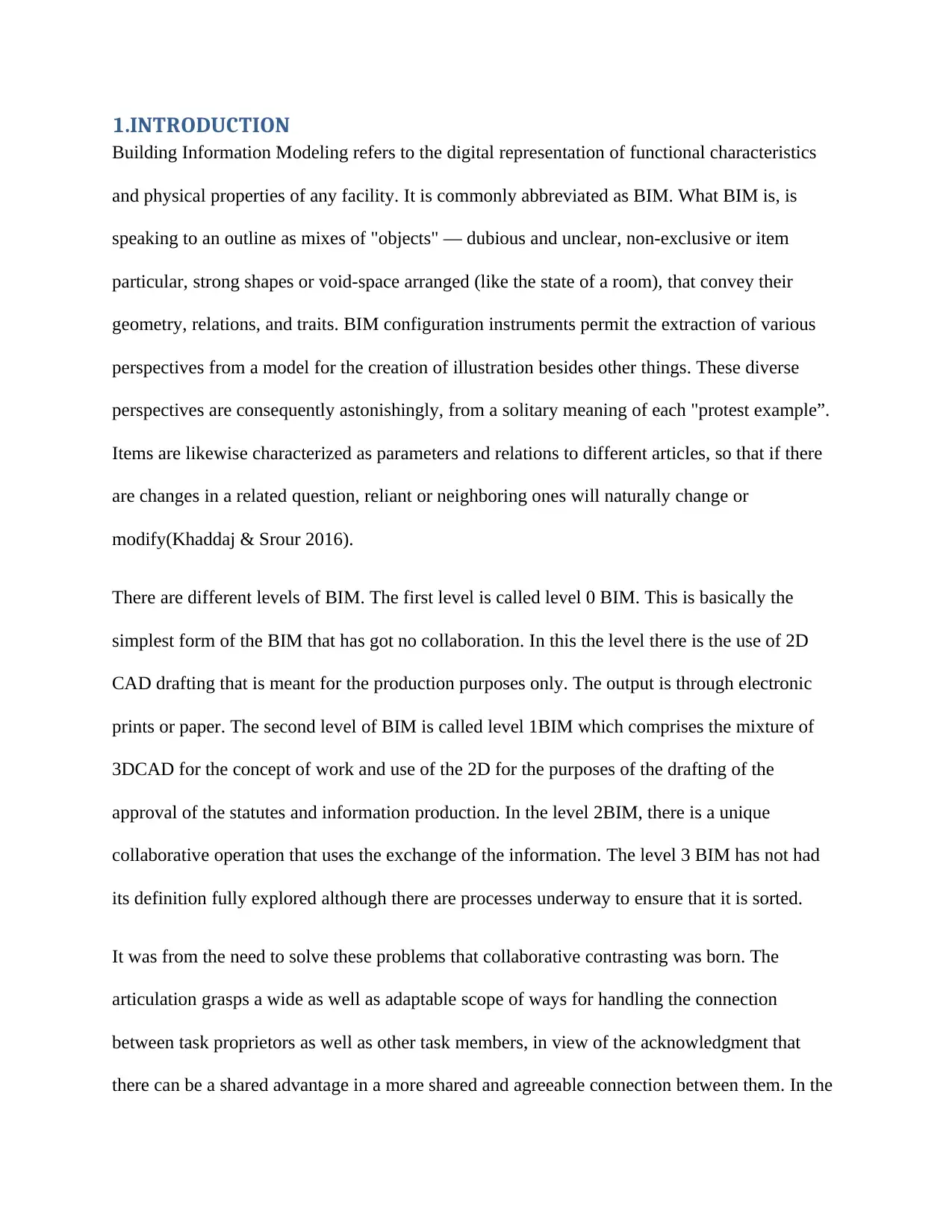
1.INTRODUCTION
Building Information Modeling refers to the digital representation of functional characteristics
and physical properties of any facility. It is commonly abbreviated as BIM. What BIM is, is
speaking to an outline as mixes of "objects" — dubious and unclear, non-exclusive or item
particular, strong shapes or void-space arranged (like the state of a room), that convey their
geometry, relations, and traits. BIM configuration instruments permit the extraction of various
perspectives from a model for the creation of illustration besides other things. These diverse
perspectives are consequently astonishingly, from a solitary meaning of each "protest example”.
Items are likewise characterized as parameters and relations to different articles, so that if there
are changes in a related question, reliant or neighboring ones will naturally change or
modify(Khaddaj & Srour 2016).
There are different levels of BIM. The first level is called level 0 BIM. This is basically the
simplest form of the BIM that has got no collaboration. In this the level there is the use of 2D
CAD drafting that is meant for the production purposes only. The output is through electronic
prints or paper. The second level of BIM is called level 1BIM which comprises the mixture of
3DCAD for the concept of work and use of the 2D for the purposes of the drafting of the
approval of the statutes and information production. In the level 2BIM, there is a unique
collaborative operation that uses the exchange of the information. The level 3 BIM has not had
its definition fully explored although there are processes underway to ensure that it is sorted.
It was from the need to solve these problems that collaborative contrasting was born. The
articulation grasps a wide as well as adaptable scope of ways for handling the connection
between task proprietors as well as other task members, in view of the acknowledgment that
there can be a shared advantage in a more shared and agreeable connection between them. In the
Building Information Modeling refers to the digital representation of functional characteristics
and physical properties of any facility. It is commonly abbreviated as BIM. What BIM is, is
speaking to an outline as mixes of "objects" — dubious and unclear, non-exclusive or item
particular, strong shapes or void-space arranged (like the state of a room), that convey their
geometry, relations, and traits. BIM configuration instruments permit the extraction of various
perspectives from a model for the creation of illustration besides other things. These diverse
perspectives are consequently astonishingly, from a solitary meaning of each "protest example”.
Items are likewise characterized as parameters and relations to different articles, so that if there
are changes in a related question, reliant or neighboring ones will naturally change or
modify(Khaddaj & Srour 2016).
There are different levels of BIM. The first level is called level 0 BIM. This is basically the
simplest form of the BIM that has got no collaboration. In this the level there is the use of 2D
CAD drafting that is meant for the production purposes only. The output is through electronic
prints or paper. The second level of BIM is called level 1BIM which comprises the mixture of
3DCAD for the concept of work and use of the 2D for the purposes of the drafting of the
approval of the statutes and information production. In the level 2BIM, there is a unique
collaborative operation that uses the exchange of the information. The level 3 BIM has not had
its definition fully explored although there are processes underway to ensure that it is sorted.
It was from the need to solve these problems that collaborative contrasting was born. The
articulation grasps a wide as well as adaptable scope of ways for handling the connection
between task proprietors as well as other task members, in view of the acknowledgment that
there can be a shared advantage in a more shared and agreeable connection between them. In the
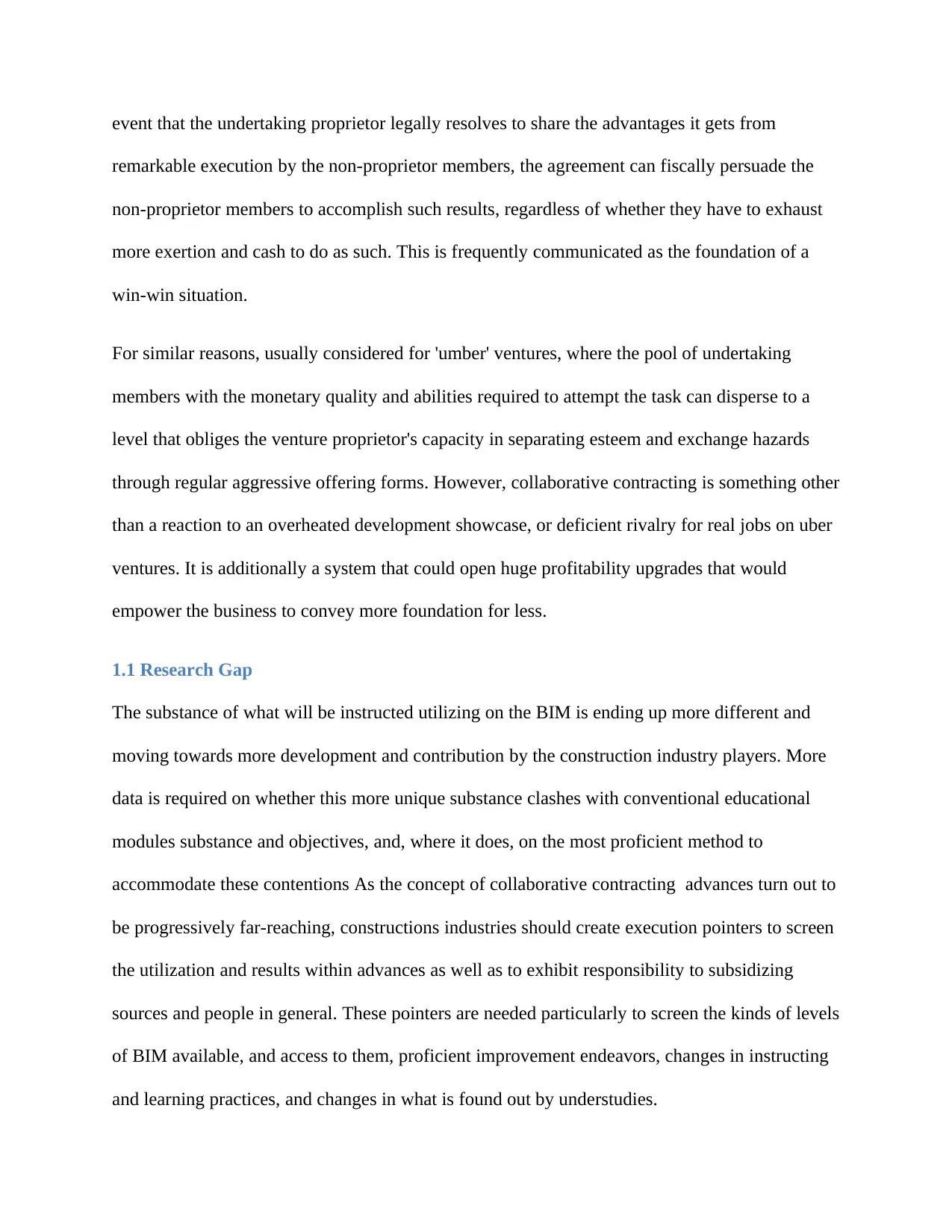
event that the undertaking proprietor legally resolves to share the advantages it gets from
remarkable execution by the non-proprietor members, the agreement can fiscally persuade the
non-proprietor members to accomplish such results, regardless of whether they have to exhaust
more exertion and cash to do as such. This is frequently communicated as the foundation of a
win-win situation.
For similar reasons, usually considered for 'umber' ventures, where the pool of undertaking
members with the monetary quality and abilities required to attempt the task can disperse to a
level that obliges the venture proprietor's capacity in separating esteem and exchange hazards
through regular aggressive offering forms. However, collaborative contracting is something other
than a reaction to an overheated development showcase, or deficient rivalry for real jobs on uber
ventures. It is additionally a system that could open huge profitability upgrades that would
empower the business to convey more foundation for less.
1.1 Research Gap
The substance of what will be instructed utilizing on the BIM is ending up more different and
moving towards more development and contribution by the construction industry players. More
data is required on whether this more unique substance clashes with conventional educational
modules substance and objectives, and, where it does, on the most proficient method to
accommodate these contentions As the concept of collaborative contracting advances turn out to
be progressively far-reaching, constructions industries should create execution pointers to screen
the utilization and results within advances as well as to exhibit responsibility to subsidizing
sources and people in general. These pointers are needed particularly to screen the kinds of levels
of BIM available, and access to them, proficient improvement endeavors, changes in instructing
and learning practices, and changes in what is found out by understudies.
remarkable execution by the non-proprietor members, the agreement can fiscally persuade the
non-proprietor members to accomplish such results, regardless of whether they have to exhaust
more exertion and cash to do as such. This is frequently communicated as the foundation of a
win-win situation.
For similar reasons, usually considered for 'umber' ventures, where the pool of undertaking
members with the monetary quality and abilities required to attempt the task can disperse to a
level that obliges the venture proprietor's capacity in separating esteem and exchange hazards
through regular aggressive offering forms. However, collaborative contracting is something other
than a reaction to an overheated development showcase, or deficient rivalry for real jobs on uber
ventures. It is additionally a system that could open huge profitability upgrades that would
empower the business to convey more foundation for less.
1.1 Research Gap
The substance of what will be instructed utilizing on the BIM is ending up more different and
moving towards more development and contribution by the construction industry players. More
data is required on whether this more unique substance clashes with conventional educational
modules substance and objectives, and, where it does, on the most proficient method to
accommodate these contentions As the concept of collaborative contracting advances turn out to
be progressively far-reaching, constructions industries should create execution pointers to screen
the utilization and results within advances as well as to exhibit responsibility to subsidizing
sources and people in general. These pointers are needed particularly to screen the kinds of levels
of BIM available, and access to them, proficient improvement endeavors, changes in instructing
and learning practices, and changes in what is found out by understudies.
⊘ This is a preview!⊘
Do you want full access?
Subscribe today to unlock all pages.

Trusted by 1+ million students worldwide
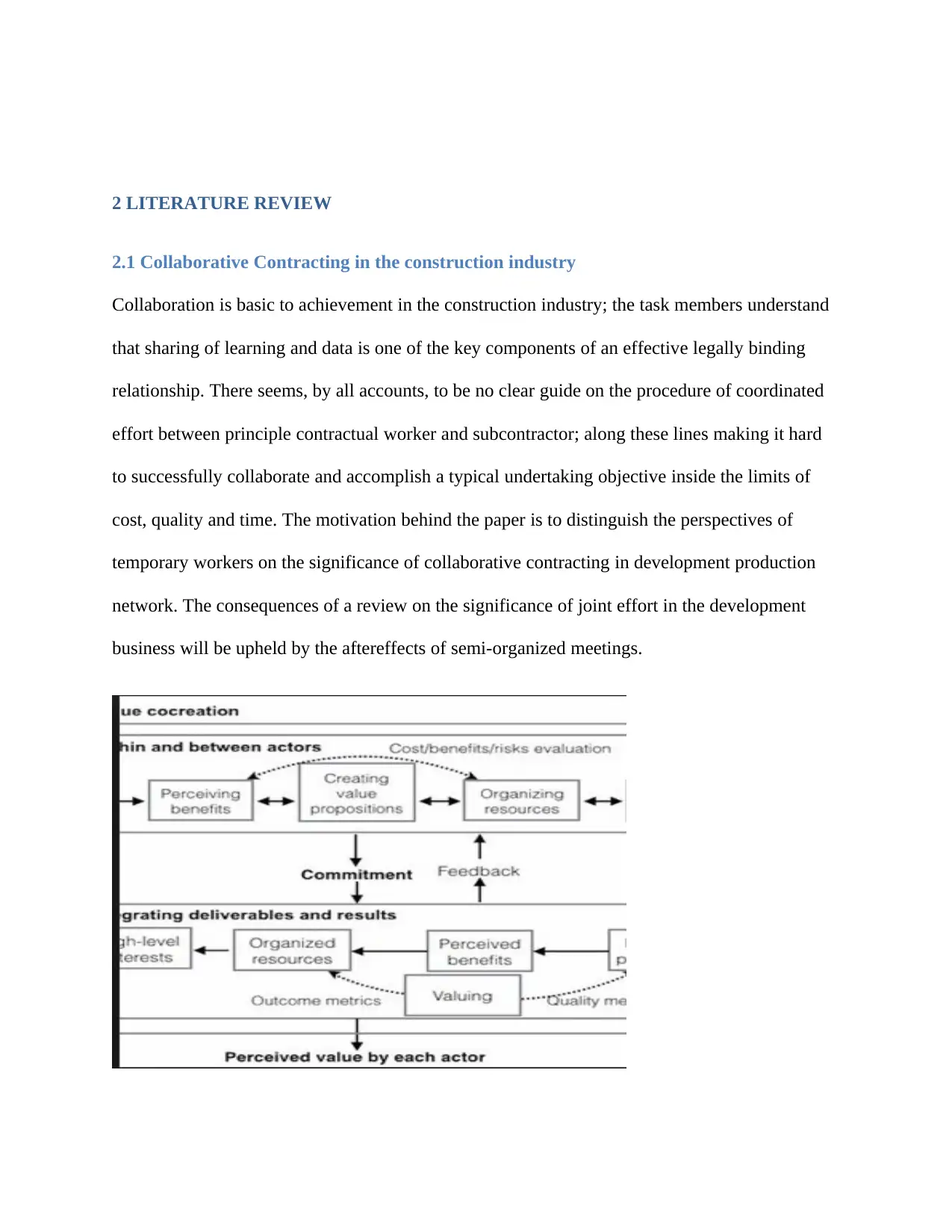
2 LITERATURE REVIEW
2.1 Collaborative Contracting in the construction industry
Collaboration is basic to achievement in the construction industry; the task members understand
that sharing of learning and data is one of the key components of an effective legally binding
relationship. There seems, by all accounts, to be no clear guide on the procedure of coordinated
effort between principle contractual worker and subcontractor; along these lines making it hard
to successfully collaborate and accomplish a typical undertaking objective inside the limits of
cost, quality and time. The motivation behind the paper is to distinguish the perspectives of
temporary workers on the significance of collaborative contracting in development production
network. The consequences of a review on the significance of joint effort in the development
business will be upheld by the aftereffects of semi-organized meetings.
2.1 Collaborative Contracting in the construction industry
Collaboration is basic to achievement in the construction industry; the task members understand
that sharing of learning and data is one of the key components of an effective legally binding
relationship. There seems, by all accounts, to be no clear guide on the procedure of coordinated
effort between principle contractual worker and subcontractor; along these lines making it hard
to successfully collaborate and accomplish a typical undertaking objective inside the limits of
cost, quality and time. The motivation behind the paper is to distinguish the perspectives of
temporary workers on the significance of collaborative contracting in development production
network. The consequences of a review on the significance of joint effort in the development
business will be upheld by the aftereffects of semi-organized meetings.
Paraphrase This Document
Need a fresh take? Get an instant paraphrase of this document with our AI Paraphraser
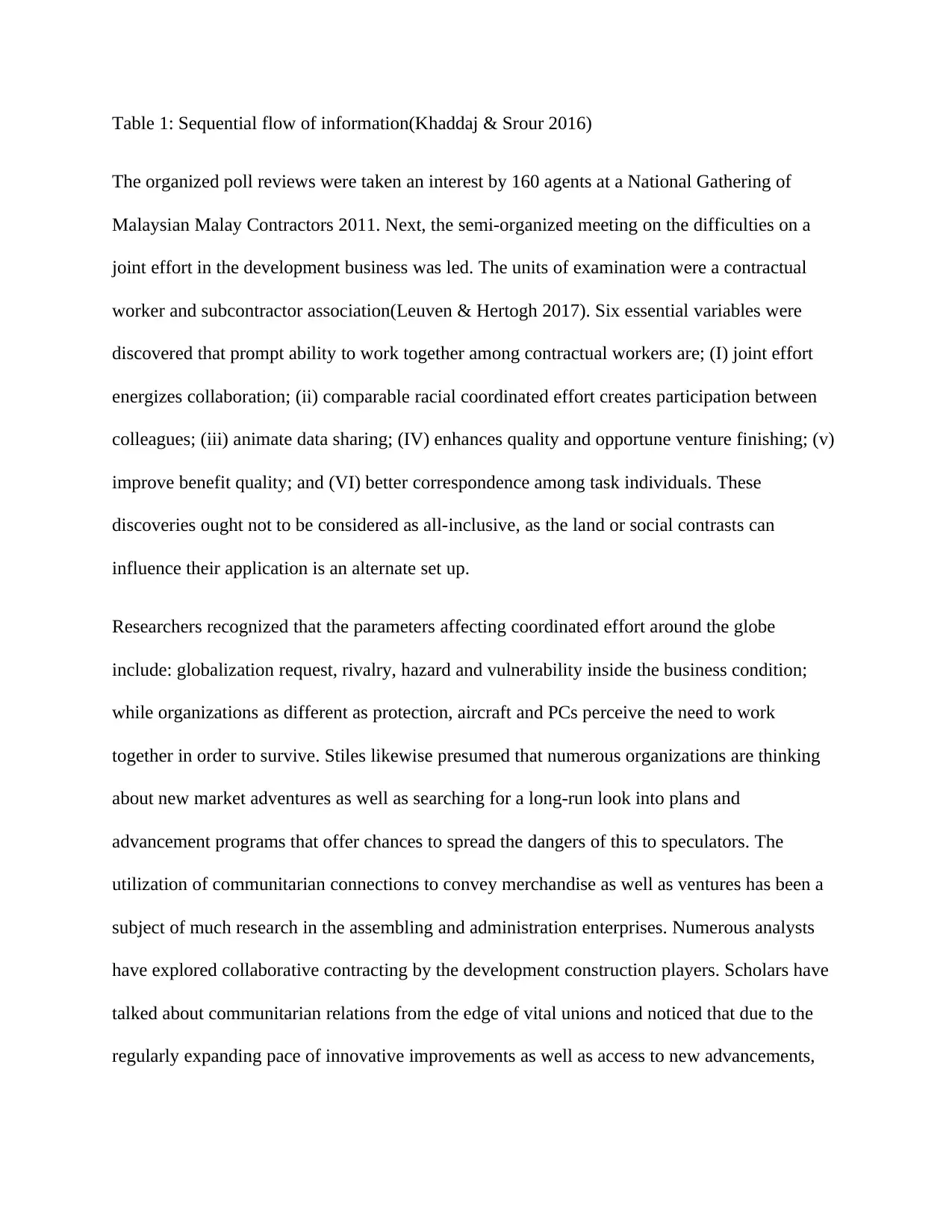
Table 1: Sequential flow of information(Khaddaj & Srour 2016)
The organized poll reviews were taken an interest by 160 agents at a National Gathering of
Malaysian Malay Contractors 2011. Next, the semi-organized meeting on the difficulties on a
joint effort in the development business was led. The units of examination were a contractual
worker and subcontractor association(Leuven & Hertogh 2017). Six essential variables were
discovered that prompt ability to work together among contractual workers are; (I) joint effort
energizes collaboration; (ii) comparable racial coordinated effort creates participation between
colleagues; (iii) animate data sharing; (IV) enhances quality and opportune venture finishing; (v)
improve benefit quality; and (VI) better correspondence among task individuals. These
discoveries ought not to be considered as all-inclusive, as the land or social contrasts can
influence their application is an alternate set up.
Researchers recognized that the parameters affecting coordinated effort around the globe
include: globalization request, rivalry, hazard and vulnerability inside the business condition;
while organizations as different as protection, aircraft and PCs perceive the need to work
together in order to survive. Stiles likewise presumed that numerous organizations are thinking
about new market adventures as well as searching for a long-run look into plans and
advancement programs that offer chances to spread the dangers of this to speculators. The
utilization of communitarian connections to convey merchandise as well as ventures has been a
subject of much research in the assembling and administration enterprises. Numerous analysts
have explored collaborative contracting by the development construction players. Scholars have
talked about communitarian relations from the edge of vital unions and noticed that due to the
regularly expanding pace of innovative improvements as well as access to new advancements,
The organized poll reviews were taken an interest by 160 agents at a National Gathering of
Malaysian Malay Contractors 2011. Next, the semi-organized meeting on the difficulties on a
joint effort in the development business was led. The units of examination were a contractual
worker and subcontractor association(Leuven & Hertogh 2017). Six essential variables were
discovered that prompt ability to work together among contractual workers are; (I) joint effort
energizes collaboration; (ii) comparable racial coordinated effort creates participation between
colleagues; (iii) animate data sharing; (IV) enhances quality and opportune venture finishing; (v)
improve benefit quality; and (VI) better correspondence among task individuals. These
discoveries ought not to be considered as all-inclusive, as the land or social contrasts can
influence their application is an alternate set up.
Researchers recognized that the parameters affecting coordinated effort around the globe
include: globalization request, rivalry, hazard and vulnerability inside the business condition;
while organizations as different as protection, aircraft and PCs perceive the need to work
together in order to survive. Stiles likewise presumed that numerous organizations are thinking
about new market adventures as well as searching for a long-run look into plans and
advancement programs that offer chances to spread the dangers of this to speculators. The
utilization of communitarian connections to convey merchandise as well as ventures has been a
subject of much research in the assembling and administration enterprises. Numerous analysts
have explored collaborative contracting by the development construction players. Scholars have
talked about communitarian relations from the edge of vital unions and noticed that due to the
regularly expanding pace of innovative improvements as well as access to new advancements,

partnerships have turned into a key achievement factor in numerous businesses (Shafiq,
Matthews & Lockley 2013).
Furthermore, they found that there was a move from "customary" cost-driven collusions to
learning escalated unions, where between accomplices learning was a noteworthy target. Stiles
showed that effective collective associations alongside key unions ought to have been created as
a component of the general system of development association, for example, distinguishing proof
of clear objectives and destinations, and huge thoughtfulness regarding the decision and kind of
accomplice. Crouse summarized that intensity of associations had imperative jobs that were
specified by the reasonable points of interest of adjusted association relationship: collaborating
gave the capacity to use interior speculations; center on center capabilities; use center skills of
different associations; decrease capital needs; widen item contributions; get entrance or quicker
passage into new markets; share rare assets; spread hazard and opportunity; enhance quality and
efficiency; approach elective innovations; give rivalry to in-house designers; utilize a bigger
ability pool; and fulfill the client(Porwal & Hewage 2013).
2.2 Building Information Modeling (BIM) for collaboration
Building Information Modeling (BIM) offers rich open doors for utilizing data innovations to
evaluate as well as co-ordinate constructions more adequately. BIM advancements have been
created essentially as an answer to data and co-appointment issues. Communitarian working can
possibly use social connections furthermore, diminishing clashes and advantage within groups
and all through supply chains. Future variants of Collaborative BIM may have the capacity to
join the upsides of both, fundamentally diminishing undertaking costs as well as enhancing
inventory network productivity. This report traces discoveries from an exploration venture
investigating the potential alongside traps of coordinated effort, what's more, coordinating these
Matthews & Lockley 2013).
Furthermore, they found that there was a move from "customary" cost-driven collusions to
learning escalated unions, where between accomplices learning was a noteworthy target. Stiles
showed that effective collective associations alongside key unions ought to have been created as
a component of the general system of development association, for example, distinguishing proof
of clear objectives and destinations, and huge thoughtfulness regarding the decision and kind of
accomplice. Crouse summarized that intensity of associations had imperative jobs that were
specified by the reasonable points of interest of adjusted association relationship: collaborating
gave the capacity to use interior speculations; center on center capabilities; use center skills of
different associations; decrease capital needs; widen item contributions; get entrance or quicker
passage into new markets; share rare assets; spread hazard and opportunity; enhance quality and
efficiency; approach elective innovations; give rivalry to in-house designers; utilize a bigger
ability pool; and fulfill the client(Porwal & Hewage 2013).
2.2 Building Information Modeling (BIM) for collaboration
Building Information Modeling (BIM) offers rich open doors for utilizing data innovations to
evaluate as well as co-ordinate constructions more adequately. BIM advancements have been
created essentially as an answer to data and co-appointment issues. Communitarian working can
possibly use social connections furthermore, diminishing clashes and advantage within groups
and all through supply chains. Future variants of Collaborative BIM may have the capacity to
join the upsides of both, fundamentally diminishing undertaking costs as well as enhancing
inventory network productivity. This report traces discoveries from an exploration venture
investigating the potential alongside traps of coordinated effort, what's more, coordinating these
⊘ This is a preview!⊘
Do you want full access?
Subscribe today to unlock all pages.

Trusted by 1+ million students worldwide

with an examination of BIM (Costa & Tavares 2012). Utilizing interviews and online reviews,
novel bits of knowledge from social financial matters and motivating force hypothesis are
connected to examinations of shared working and the potential of BIM as toolboxes, not just to
enhance data streams, yet additionally to empower community working practices, especially for
lower levels of supply chains where little and medium measured endeavors (SMEs) are
unequivocally spoken to.
Building Information Modeling (BIM) is an arrangement of computerized instruments used to
catch the useful and plan qualities of a building. It is essentially collective since it is about data
sharing over the different organizations what's more, inside the between disciplinary groups on
development ventures. The pith of the idea was laid out by van, with a down to earth layout of
BIM as a development arrangement set out via Autodesk. There is no outright definition or
variant of BIM – BIM programming is provided by a scope of associations, yet Autodesk is
currently, by a wide edge, the market pioneer. BIM is developing quickly constantly, and current
practices are evolving quickly; with options in contrast to the standard BIM approach being
developed too.2 BIM's sources lie in compositional plan, and have advanced from Computer
Aided Design (CAD) – concocted practically speaking as a typical record of plans and
illustrations for a building – at first in 2D frame empowered by 2D CAD, later moving to 3D
CAD adaptations (Forsythe 2014).
In correlation with antiquated strategies for drawn plans, the mechanical developments offered
noteworthy favorable circumstances as far as digitized plan and representation. All the more as
of late this has developed into BIM models implanting conventions broadening information and
record sharing to higher "measurements". After some time, BIM has been reached out to Levels
2 and 3, with more noteworthy center around measurements of development sequencing and
novel bits of knowledge from social financial matters and motivating force hypothesis are
connected to examinations of shared working and the potential of BIM as toolboxes, not just to
enhance data streams, yet additionally to empower community working practices, especially for
lower levels of supply chains where little and medium measured endeavors (SMEs) are
unequivocally spoken to.
Building Information Modeling (BIM) is an arrangement of computerized instruments used to
catch the useful and plan qualities of a building. It is essentially collective since it is about data
sharing over the different organizations what's more, inside the between disciplinary groups on
development ventures. The pith of the idea was laid out by van, with a down to earth layout of
BIM as a development arrangement set out via Autodesk. There is no outright definition or
variant of BIM – BIM programming is provided by a scope of associations, yet Autodesk is
currently, by a wide edge, the market pioneer. BIM is developing quickly constantly, and current
practices are evolving quickly; with options in contrast to the standard BIM approach being
developed too.2 BIM's sources lie in compositional plan, and have advanced from Computer
Aided Design (CAD) – concocted practically speaking as a typical record of plans and
illustrations for a building – at first in 2D frame empowered by 2D CAD, later moving to 3D
CAD adaptations (Forsythe 2014).
In correlation with antiquated strategies for drawn plans, the mechanical developments offered
noteworthy favorable circumstances as far as digitized plan and representation. All the more as
of late this has developed into BIM models implanting conventions broadening information and
record sharing to higher "measurements". After some time, BIM has been reached out to Levels
2 and 3, with more noteworthy center around measurements of development sequencing and
Paraphrase This Document
Need a fresh take? Get an instant paraphrase of this document with our AI Paraphraser
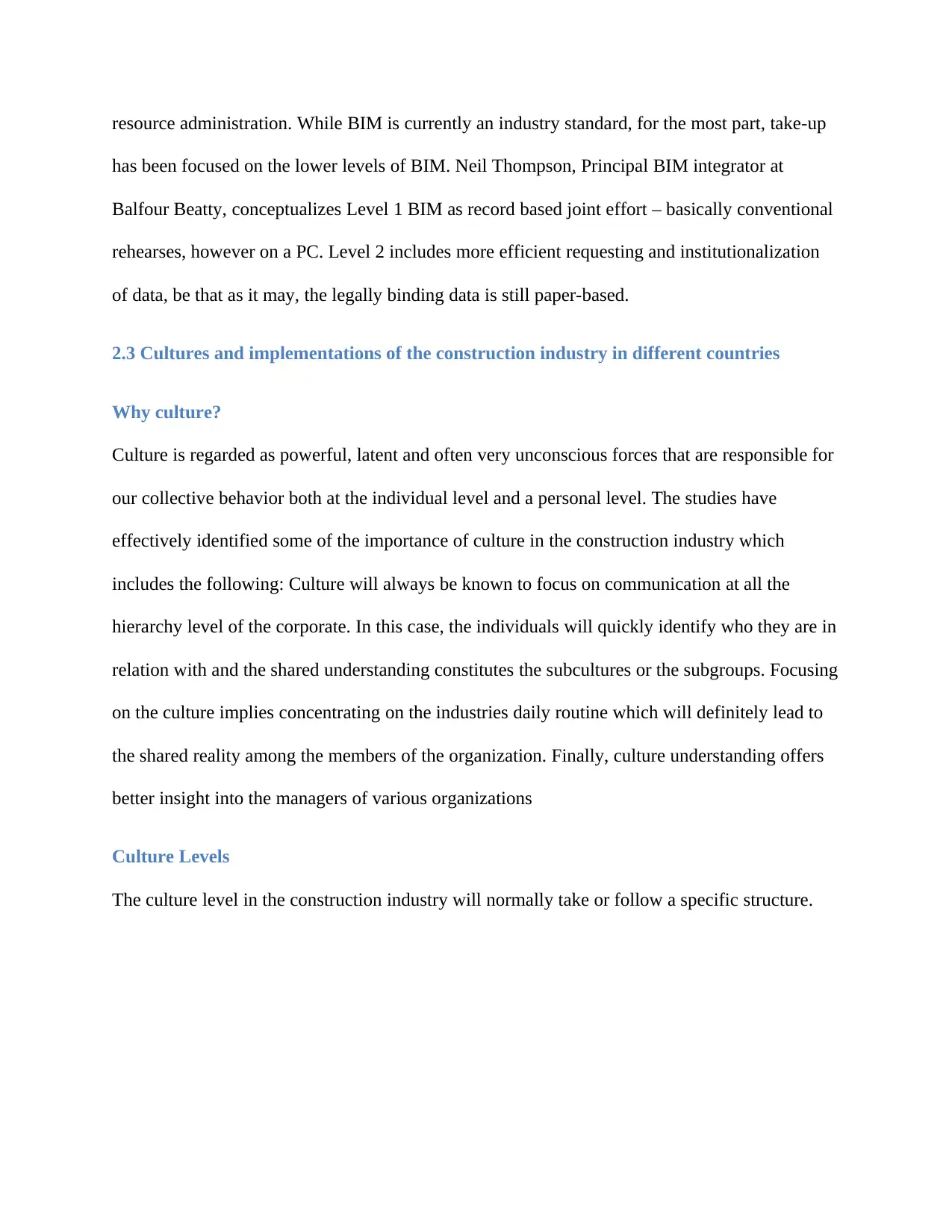
resource administration. While BIM is currently an industry standard, for the most part, take-up
has been focused on the lower levels of BIM. Neil Thompson, Principal BIM integrator at
Balfour Beatty, conceptualizes Level 1 BIM as record based joint effort – basically conventional
rehearses, however on a PC. Level 2 includes more efficient requesting and institutionalization
of data, be that as it may, the legally binding data is still paper-based.
2.3 Cultures and implementations of the construction industry in different countries
Why culture?
Culture is regarded as powerful, latent and often very unconscious forces that are responsible for
our collective behavior both at the individual level and a personal level. The studies have
effectively identified some of the importance of culture in the construction industry which
includes the following: Culture will always be known to focus on communication at all the
hierarchy level of the corporate. In this case, the individuals will quickly identify who they are in
relation with and the shared understanding constitutes the subcultures or the subgroups. Focusing
on the culture implies concentrating on the industries daily routine which will definitely lead to
the shared reality among the members of the organization. Finally, culture understanding offers
better insight into the managers of various organizations
Culture Levels
The culture level in the construction industry will normally take or follow a specific structure.
has been focused on the lower levels of BIM. Neil Thompson, Principal BIM integrator at
Balfour Beatty, conceptualizes Level 1 BIM as record based joint effort – basically conventional
rehearses, however on a PC. Level 2 includes more efficient requesting and institutionalization
of data, be that as it may, the legally binding data is still paper-based.
2.3 Cultures and implementations of the construction industry in different countries
Why culture?
Culture is regarded as powerful, latent and often very unconscious forces that are responsible for
our collective behavior both at the individual level and a personal level. The studies have
effectively identified some of the importance of culture in the construction industry which
includes the following: Culture will always be known to focus on communication at all the
hierarchy level of the corporate. In this case, the individuals will quickly identify who they are in
relation with and the shared understanding constitutes the subcultures or the subgroups. Focusing
on the culture implies concentrating on the industries daily routine which will definitely lead to
the shared reality among the members of the organization. Finally, culture understanding offers
better insight into the managers of various organizations
Culture Levels
The culture level in the construction industry will normally take or follow a specific structure.

Figure 1: Levels of cultures(Khaddaj & Srour 2016)
Chinese construction culture
Various social examinations demonstrated that Chinese culture is more group than
individualistic, with high vulnerability evasion and vast power removes thought about with
western societies. As it were, the Chinese are preservationist; feel awkward with vulnerability;
maintain a strategic distance from dangers, and spotlight on group advantages and
accomplishments. With higher progressive system; subordinates don't have numerous
opportunities to partake in basic leadership. The Chinese culture centers on keeping up congruity
and building trust among individuals. The face is essential for the Chinese individuals and face-
saving conduct guarantees concordance inside the gathering (Emmitt & Ruikar 2013).
Wherever conceivable, endeavors ought to be made to spare the substance of self as well as other
people. It is humiliating if confront is tested out in the open. In China, speaking to decency,
Chinese construction culture
Various social examinations demonstrated that Chinese culture is more group than
individualistic, with high vulnerability evasion and vast power removes thought about with
western societies. As it were, the Chinese are preservationist; feel awkward with vulnerability;
maintain a strategic distance from dangers, and spotlight on group advantages and
accomplishments. With higher progressive system; subordinates don't have numerous
opportunities to partake in basic leadership. The Chinese culture centers on keeping up congruity
and building trust among individuals. The face is essential for the Chinese individuals and face-
saving conduct guarantees concordance inside the gathering (Emmitt & Ruikar 2013).
Wherever conceivable, endeavors ought to be made to spare the substance of self as well as other
people. It is humiliating if confront is tested out in the open. In China, speaking to decency,
⊘ This is a preview!⊘
Do you want full access?
Subscribe today to unlock all pages.

Trusted by 1+ million students worldwide
1 out of 37
Your All-in-One AI-Powered Toolkit for Academic Success.
+13062052269
info@desklib.com
Available 24*7 on WhatsApp / Email
![[object Object]](/_next/static/media/star-bottom.7253800d.svg)
Unlock your academic potential
Copyright © 2020–2025 A2Z Services. All Rights Reserved. Developed and managed by ZUCOL.